
Table Of Contents
- What Is Internal Linking?
- Why Should You Create Internal Links?
- 1. Organizing Your Website
- 2. Increases Crawl Rate And Site Indexing
- 3. Helps You Gain Topical Authority
- 4. Boosts Your Revenue
- What Are The Common Internal Linking Mistakes?
- How To Build Internal Links For SEO? (Some Best Practices)
- 1. Keep Internal Links Relevant
- 2. Get the Right Links To Improve SERPs
- 3. Follow A Silo Structure
- Additional WordPress Internal Linking Tips
Is it possible to boost the SEO performance of a website without building backlinks? As I have been blogging for over a decade, I would say, “Yes.”
Do you wonder how?
We can take SEO to a new height and get improved search engine rankings through the “Internal Link Building” technique.
Doing WordPress internal linking for more than ten years, I can guide you in doing it correctly, and it will tweak your SEO results and user experience.
So, let’s start with the basics!
What Is Internal Linking?
Look at the below image!
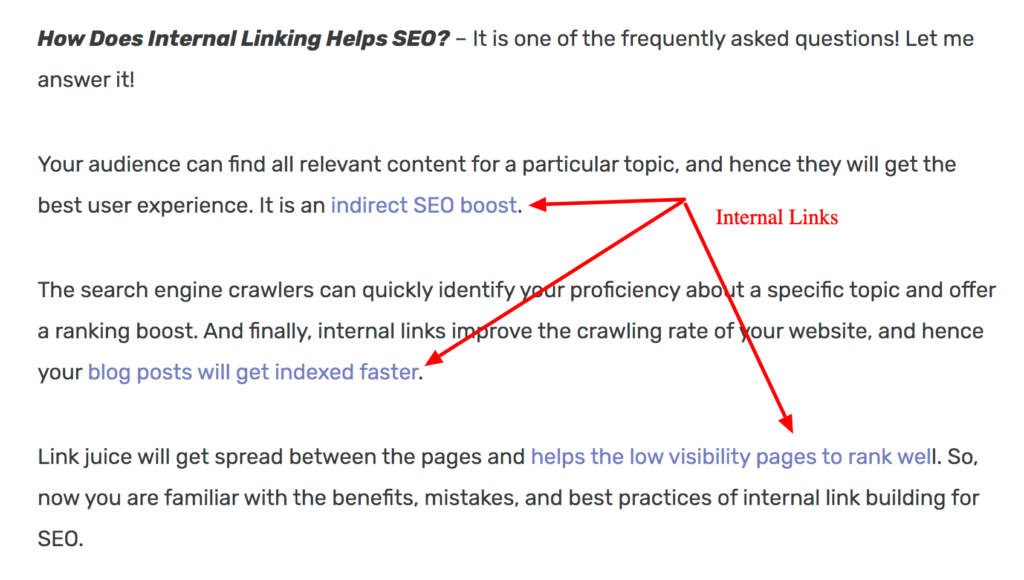
I hope you know about a backlink, a hyperlinking between two websites. When we create a hyperlink to another page of the same site or blog, it is called an “Internal Link.”
It is self-explanatory from the name – Internal, which is nothing but connecting the pages of the same domain.
Internal linking is the best way to display relevant content for your audience and search engines. It passes the authority from one page to another.
If it is done right, you will reap the search engine benefits; otherwise, you may get a negative impact that would ruin the SEO performance of your website.
Negative Impact?
Yes! you may face the ranking down issue if your strategy is incorrect!
So, how to create a correct internal linking structure for SEO? Before getting into the best practices, let me tell you the benefits of executing the interlinking process.
Why Should You Create Internal Links?
What are the benefits of internal link building for WordPress website or blog? – It is the most commonly asked question by a beginner!
Now, let’s see some valid reasons for creating internal links in the content!
1. Organizing Your Website
A good internal linking structure will help you to organize your website. You are making the navigation easy for your readers and making an ideal roadmap for your site that would offer a better customer experience.
Likewise, through a well-planned content linking architecture, you are letting Google and other search engines to rank your individual pages as you are connecting the related pages in a hierarchy.
2. Increases Crawl Rate And Site Indexing
As you are linking the existing article to the new piece of content that you write, the Google crawl rate of your site will get increase. Site crawling is an essential SEO aspect that helps to index your articles more deeply and quickly.
WordPress Internal linking lets the search engine bots to crawl your site properly. A site with proper navigation will result in successful page indexing, and finally, you will get a deserving ranking position for your freshly baked content.
3. Helps You Gain Topical Authority
Do you aware of Topical authority? It is about your expertise on a particular topic. So, how could you establish your topical authority? Digging more in-depth on the same topic and interlinking all the content would improve the topical relevance.
After gaining the topical authority, it would be easier for you to rank high on Google search results even for the high-competitive keywords.
4. Boosts Your Revenue
You heard it right! If you have monetized your site with affiliate marketing, then you can use the internal links to funnel the traffic toward the high-converting landing pages. When you make the readers act on the sales page, your revenue will get boosted.
You may also route them to download your free or premium guide meant for list building. You know the well-known marketing proverb – “Money Is In The List”; More Subscribers = More Money. So, funneling your audience through internal linking would indirectly increase your business profits.
What Are The Common Internal Linking Mistakes?
The internal links pass the link juice between the pages and distribute the authority. So, you should avoid some common mistakes like,
1. Rich Anchor Text Optimization
The Clickable text in the hyperlink is Anchor text, and it should be made in the right way. When you want to rank the article for a particular keyword, then you should not use the same keyword phrase every time when you are linking the article.
In 2012 Google Panda algorithm, it has clearly been mentioned that too much of the exact match anchor text turns out to be an unnatural link building strategy that would lead to site penalization.
2. Too Many Links
Creating too many internal links on every paragraph wouldn’t look natural and it affects the readability as well. Yes, your audience would get annoyed with the excess links even though if they are relevant.
3. Linking Irrelevant Content
To create internal links, adding irrelevant pages is the biggest blunder that would suppress your SEO value. The links you add should provide value to your visitors and signal to the search engines that you offer topical relevance to the content.
4. Adding Nofollow Links
The purpose of WordPress internal linking is to tell the search engines how important your pages are. There is no point in adding the no-follow tag to the internal links, and yes, you should allow the search engines to crawl them.
5. Other Internal Linking Mistakes
- Adding links in the sub-heading would affect the reading flow and distract your readers.
- Having broken links – Sending the visitors to your pages that are not working.
- Keeping lengthy anchor text – Adding internal links to a long sentence or paragraph.
How To Build Internal Links For SEO? (Some Best Practices)
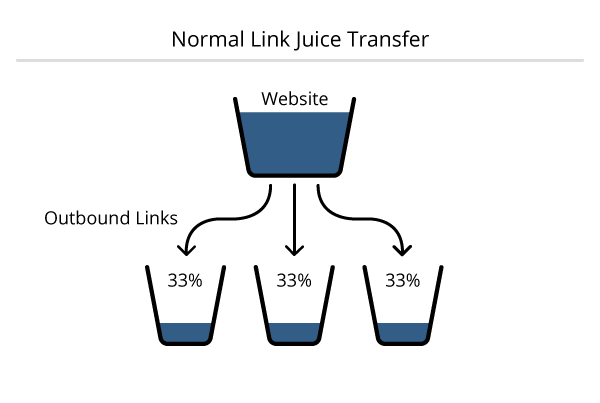
How to do internal linking in the right way for SEO? – It’s a million-dollar question!
Through my knowledge and experience, I can suggest to you some best internal linking SEO practices so that you can do well and boost your web presence.
1. Keep Internal Links Relevant
Before adding any link, think about whether it is relevant to the page that you are linking to or not. Consider yourself as a reader and ask whether it offers any value to you and is useful to act in any way.
If you feel it is good to add and believe that the link would nudge your audience to take action, then proceed to add that link. Adding irrelevant links will not help you in any way, and yes, it would spoil the user experience and affect the search engine rankings for sure.
I’m advising you to funnel the traffic through internal links. Make sure that you can take them one step further by offering the exact information about what they look for or gently push them to purchase the affiliate product that you recommend.
Don’t confuse them and let them distract you through the improper linking structure. Be clear, and they should not travel backward and fly somewhere else by not getting the right solution.
2. Get the Right Links To Improve SERPs
If you wish to rank a particular blog article, it would be better to gather some of your previous content with more value.
Now, you might ask a question: how do you find such articles? Let me guide you!
For example – You can improve the search engine ranking positions of your blog posts that rank on the 2nd page through the internal linking process!
For that, just follow the below steps.
Step 1: Collect High Authority Pages
You must be aware of your high authority pages for implementing the internal linking process in 2020 and beyond.
You may use the Moz link explorer to get the job done quickly.
When you enter your domain and click “Top Pages” you will be able to see your top authority pages, and you may pick the relevant ones for internal linking. 10 results will be available in the free version.
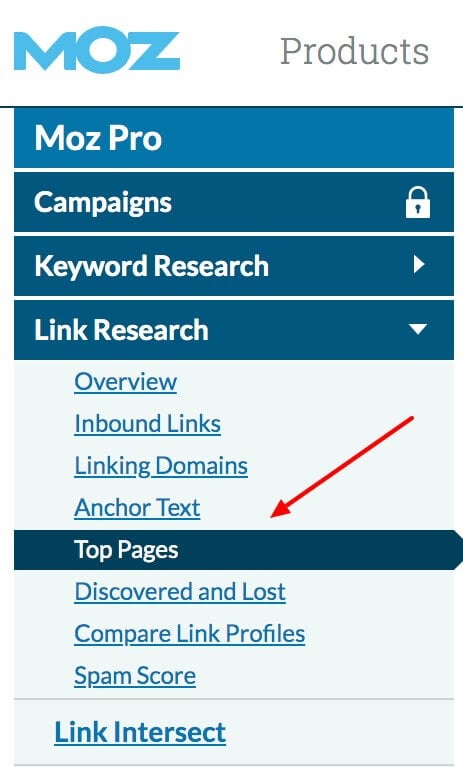
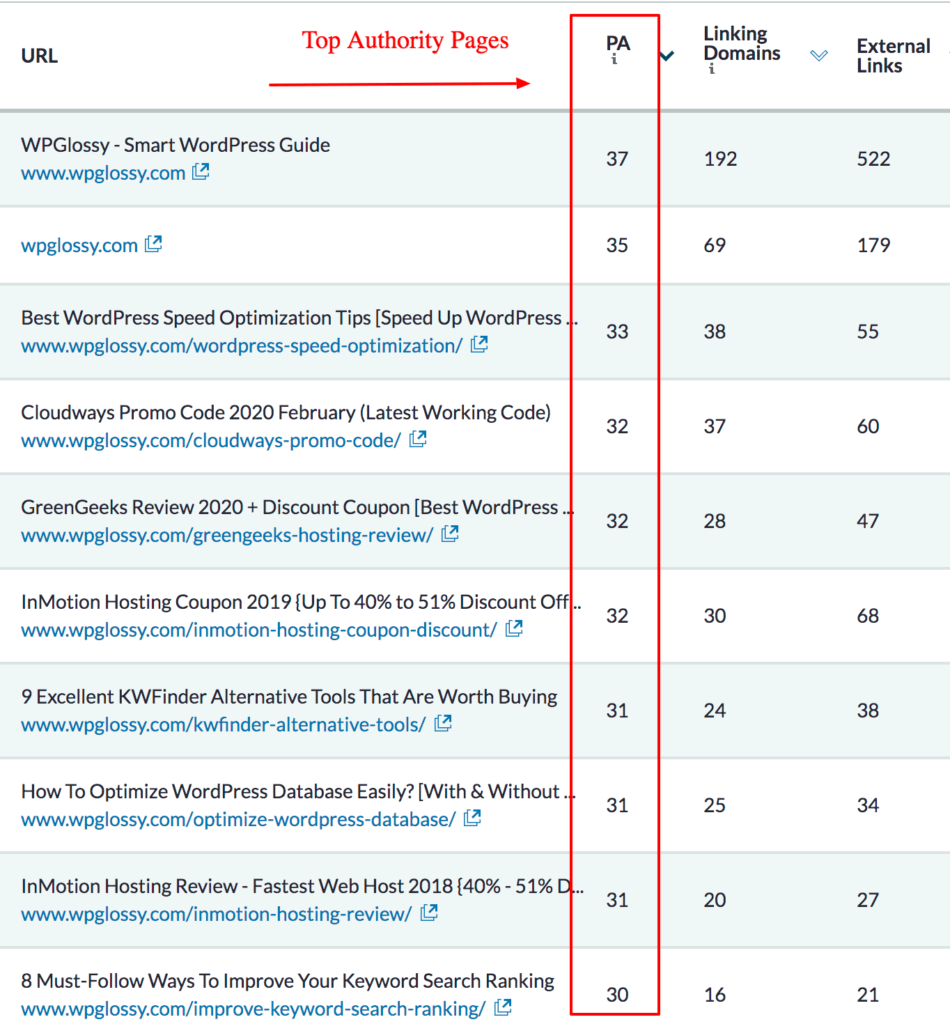
I usually use the Ahrefs SEO tool to find out the best and most appropriate internal links to include in the content.
Here you go! Go to Ahrefs > Place your Link in Site Explorer > Click “Best By Links” and add the relevant link (Possibly with high UR)
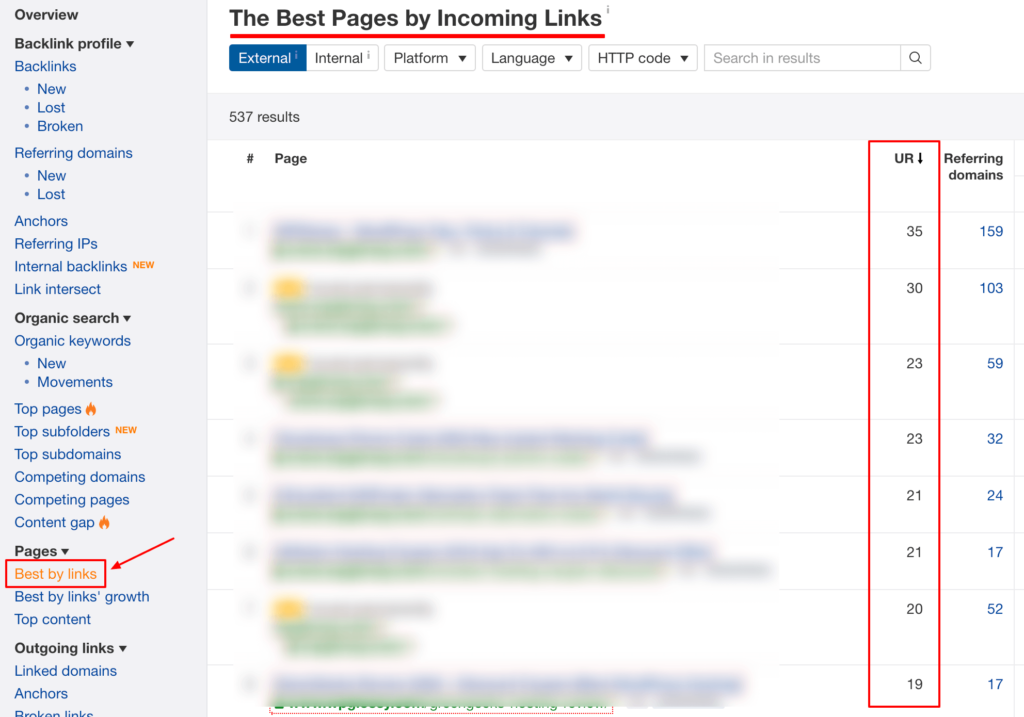
Note:
If you don’t have a paid SEO tool like Ahrefs, you may use the Google Webmaster Tools to find out the most-linking articles. Yes, you can collect such esteemed blog articles and pass the link juice to the pages that are ready for high visibility.
Go to Google Search Console > Links > External Links
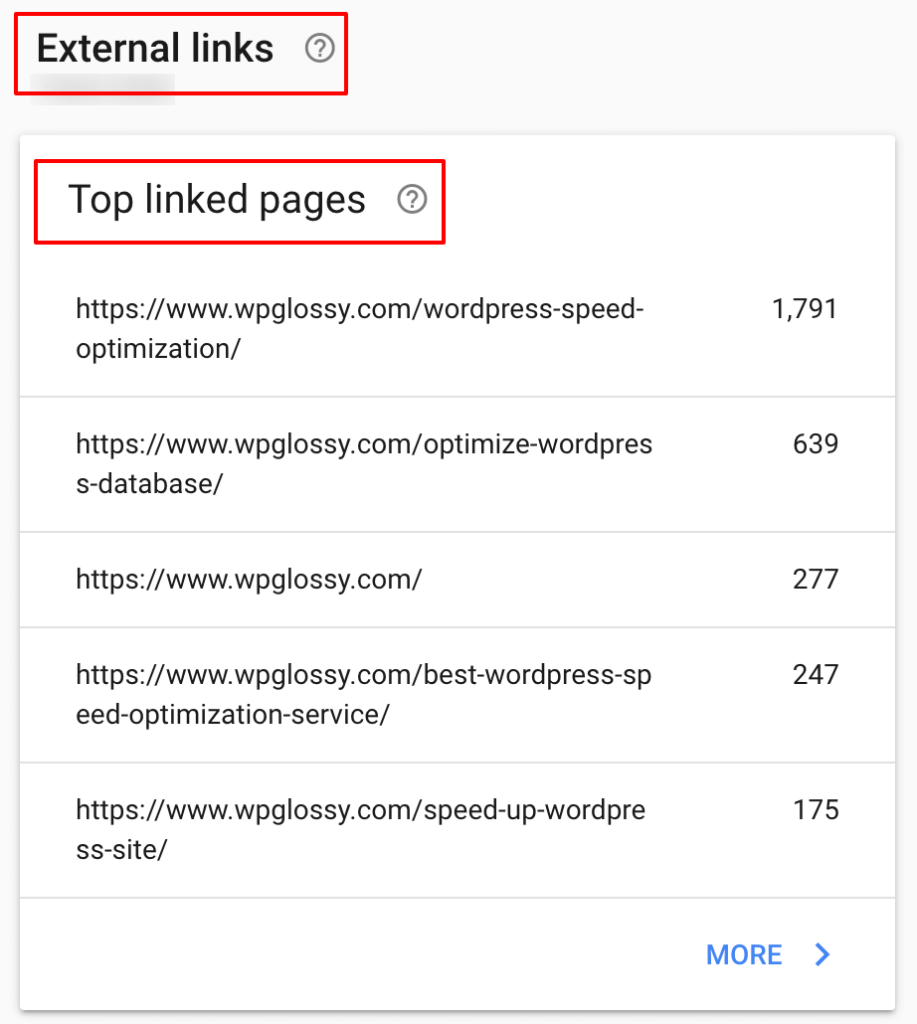
So, you have collected the pages that have high authority.
Step 2: Find The Articles ranking on the 2nd page top
To find out the page that is ready to rank high, it’s better to use the SEMRush paid SEO tool.
Go To SEMRush > Domain Analytics > Organic Research > Positions
Now, try to collect the pages that are ranking on the 11th, 12th, or 13th. Here, I’m showing you the content ranking on 11th position.
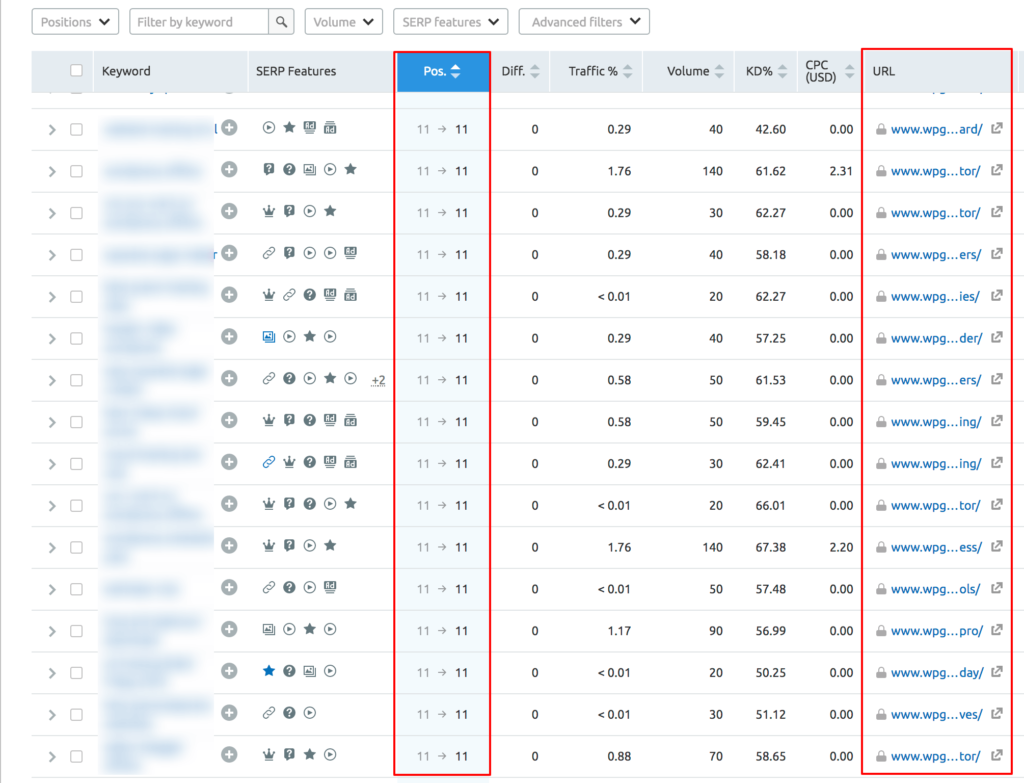
Note:
If you don’t have a paid SEO tool, use Google Search Console to find out the 2nd ranking articles.
Go to Google Search Console > Performance > Average Position
So, you have consolidated the pages that have the potential to grab high visibility.
Step 3: Link High Authority Pages To 2nd Page Articles.
Now, you have high authority pages and articles with the ability to rank high.
It’s time to link both pages meaningfully. Add the internal link to the pages ready to rank from the top authority pages (Articles on the 2nd page).
Here are a few tips to do it in a better way!
- From the list, decide which links to be interlinked from which article.
- Make sure that you are naturally adding the relevant links.
- You may choose the appropriate anchor text from the “Queries” in Google Search Console for internal linking.
As you interlink the 2nd-page blog articles to the authority pages, be ready to drive more traffic from the search engines.
Check the 11th-position articles after a week for the targeted keywords; there will definitely be a ranking boost for them.
3. Follow A Silo Structure
Have you ever heard about the SILO internal linking structure?
If yes, then you are on the right track of the internal link structure for SEO. However, if the SILO is new for you, let me explain clearly!
The meaning of SILO is Isolating a thing or department!
When it comes to SEO and website, SILO is organizing a structure for the web crawlers so that they can easily understand what you write about and the topical relationship between the articles.
Several types of SILOs can be implemented for SEO, and here, I’m talking about the Link SILO that groups the relevant content together and mapping under a specific category.
And, the primary benefit of implementing the SLIO structure is to boost SEO performance through internal linking!
A SILO structure looks like this:
Home
- Category
- Subcategory
- Subcategory
- Subcategory
- Category
- Subcategory
- Subcategory
- Subcategory
This type of structure of your site content helps to distribute the link juice for other pages.
Have a look at the below image, and you will get a clear idea!
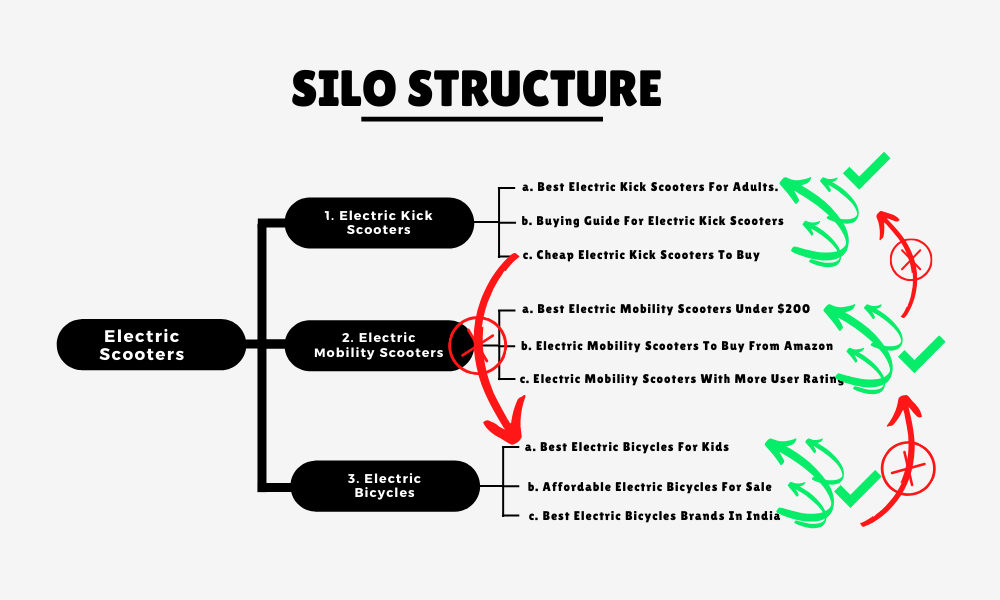
All of the category pages pass the link juice to the Homepage which in turn increases your domain and page authority.
I hope you understood that the SILO is a technique that connects the subcategories to the main category and main categories (SILO Pages) to the Homepage.
So, with the SILO content structure, you are creating a strong sitemap and letting your audience and web crawlers understand your expertise level with which you can get a high ranking in the search results.
Additional WordPress Internal Linking Tips
- When you publish new content, don’t forget to link it to the old related articles. It will help the fresh material to get a good exposure.
- When you place the internal link in the first paragraph of the blog post, then it will carry more weight.
- Make sure that you have Interlinked all your important pages from your homepage
- If you’re a beginner and don’t know how to add internal links in WordPress, you may use a third-party plugin like Link Whisper to get the job done easily.
- If you have a limited budget, don’t miss to grab Link Whisper Discount
Wrapping Up
Google and other search engines are constantly improving their algorithms to offer accurate results for search users. Hence, we need to be more attentive while implementing SEO strategies.
I hope you understand what internal linking does for SEO and how to do it correctly! So, carefully plan your internal link building structure and offer more weight to your freshly made content.
How Does Internal Linking Help SEO? – It is a frequently asked question! Let me answer it!
Your audience can find all relevant content for a particular topic, and hence they will get the best user experience. It is an indirect SEO boost.
Search engine crawlers can quickly identify your proficiency in a specific topic and offer a ranking boost. And finally, internal links improve the crawling rate of your website, and hence your blog posts will get indexed faster.
Link juice will get spread between the pages and help the low-visibility pages to rank well.
So, now you are familiar with the benefits, mistakes, and best practices of internal link building for SEO.
You may post your queries in the comment section if you have any doubts. As SEO is my cup of coffee for the past ten years, I can help you with my detailed reply.

Hello mam, you nailed it very well.
Yes internal linking boosts ranking. we have to link relevant articles each other.
we have to link from the high ranking articles to low ranking articles to boost the rankings of low ranking pages.
I applied this one on my blog and my posts pumped up.
Thank you for this post. You provided very insightful tips and strategies.
Keep come up with this awesome stuff.
Hi Nirmala,
First of all, thanks for sharing the well written content about internal linking.
I would defenitly try this startegy on my blog as well to boost SEO.
Great post. I know people who think internal linking is not beneficial for SEO and ignores it. However, there are many experts and researches that show that internal linking does boost your website’s SEO efforts. Thanks for sharing the benefits, mistakes, and best practices of internal link building. It was really helpful.
It really works. You have explained really well. Thank for sharing this post
The post is absolutely fantastic! Lots of great information and inspiration both of which we all need! Also like to admire the time and effort you put into your blog.
Honesty, I’ve learn a lot with this amazing article, now i know that internal links help to boost SEO, thank you so much
Glad you have learned from here. Keep coming!
Thank you sharing information . it is helpful for us.
very use full, past so many days I am struggling to build inner links to my site now it’s clear thank you
Thanks for such an awesome explanation. Very informative article on internal linking. Learned a lot ma’am👍
internal linking is very important foe on page SEO. This post was very good for me thank you so much sir for this post.